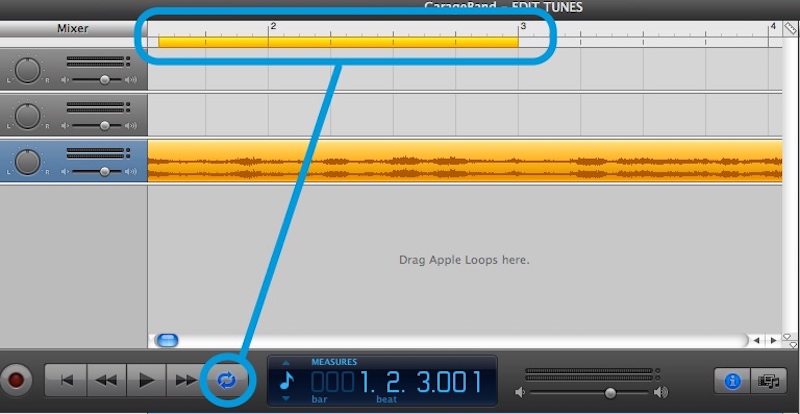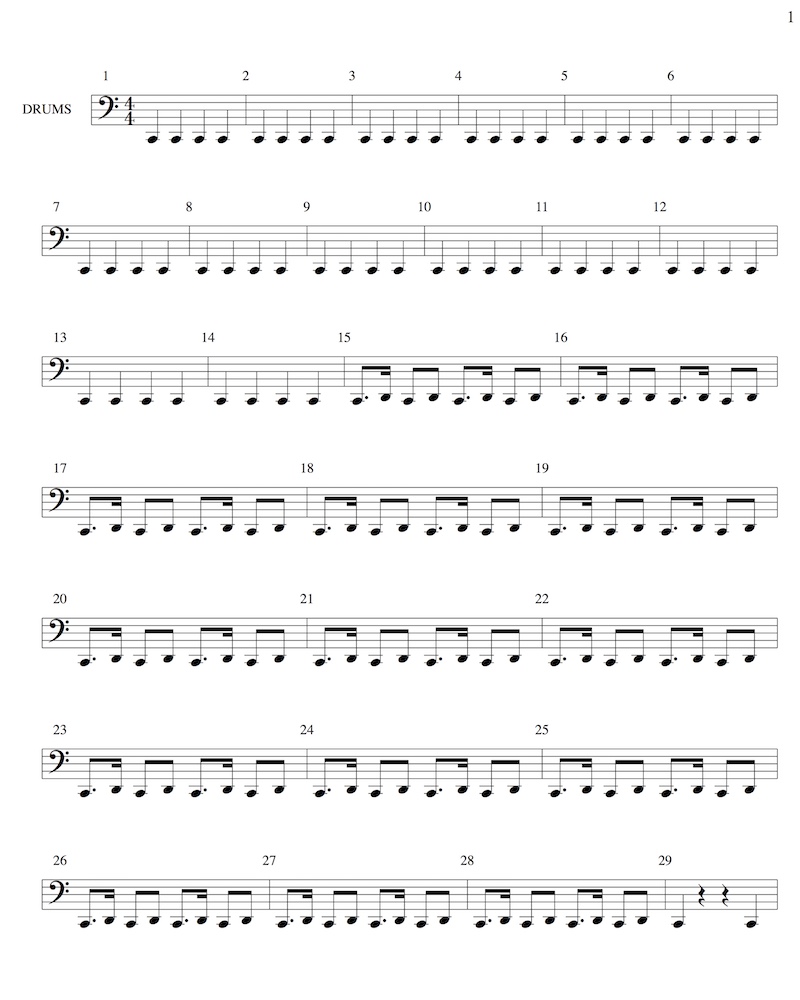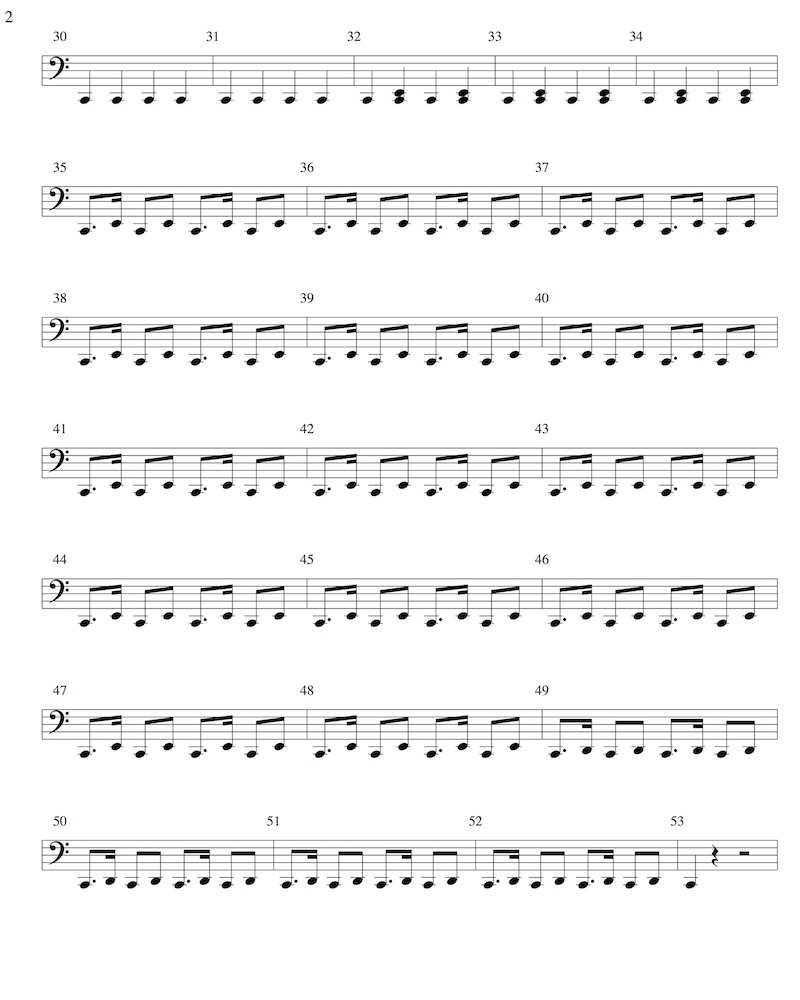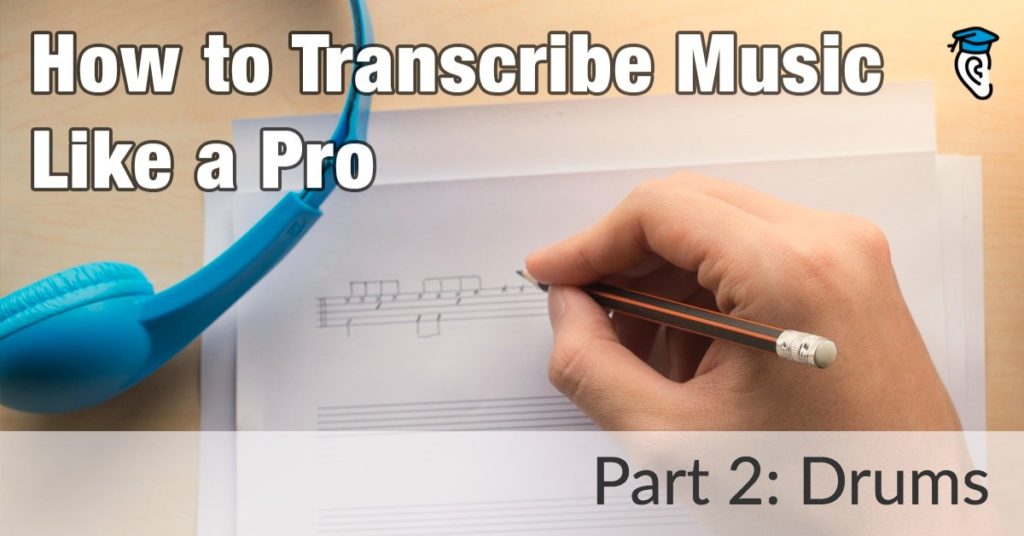In the first part of this series we covered transcription basics and what you should know before you start. So, once you are ready to start: where to begin? Music can be complex and that can make the task of transcribing it seem overwhelming!
Fortunately learning to transcribe music can be broken down into several key components. Learn about these and start by transcribing the right one, and everything else will fall into place much more easily.
It’s normally best to transcribe the drum part before anything else. Many hit tunes have very simple drum parts that repeat throughout the song. Transcribing the drums therefore gives you an easy starting point and provides a framework for all the other transcribing you will do.
Note: In the rest of this article we will refer to “drums” but we really mean percussion in general. It might be a classic rock drum kit, or it could be electronic percussion instruments or an orchestral rhythm section.
Start with the drums
Turn on your favorite tune. Chances are there is a steady drum rhythm pushing the beat and directing the musical structure of the tune. Listen to the song several times. How many times does the rhythmic pattern repeat in a row? When does it actually change? Does the drum part match up with the different sections of the song like the intro, verse, chorus and bridge?
The drum part in Imagine Dragons “Radioactive” is simple, but binds the entire song together:
Meghan Trainor’s “Future Husband” tune has a playful drumbeat reminiscent of 1950s rock:
The drum part normally provides the basic rhythmic structure of the entire tune, especially in styles like pop or dance music. Many times the bass player and keyboardist follow some variation of the drum part. This means the drums can help you understand the song structure (like the intro, verses, chorus, and bridge), providing a good skeleton for filling in the rest.
How to Transcribe Drums
Throughout this series we will use a simple instrumental track to highlight different transcription steps. Based on popular modern music styles, this example is a good basic track to start work on transcription. Other musical styles like jazz, hip hop, and rock may have more complex structures, harmonies, and rhythms, which represent a next-level challenge. For this introductory series we’ll focus on pop music as a good starting point.
Listen to the sample instrumental below one time:
The drum part in the sample provides basic direction to the song structure. While there are some minor variations, you can hear that there are essentially two sounds – a deep bass sound and a “snare” sound. Many tracks will also include cymbals, high hats, toms, and synthesized sounds.
If you need some help identifying different components of a drum set, check out this tutorial on recognising the parts of the drum kit.
Step One: Figure Out the Time Signature
Before you can transcribe any song, you need to figure out the time signature. The time signature essentially tells you how many beats there are for each measure. Knowing what the tempo is can be as easy as 1-2-3…
- Listen to the sample audio track
- Try counting with the track, using 1-2-3
- Try counting with the track, using 1-2-3-4
- Try counting with the track using 1-2
When you count using 1-2-3, the beats seem off, and “1” never seems to fall in the right place.
Can you hear how counting in 3/4 time does not fit the natural time signature of this tune?
Both counting 1-2-3-4 and 1-2 seem to work. In most cases, you will have four beats per measure (or 4/4) rather than two. In fact most mainstream songs you hear day-to-day have a basic 4/4 time signature. Some rock songs do delve into 3/4 and 6/8 time signatures, but for our purposes here, the example track is in 4/4 time.
Listen to the track several times and identify each section based on the drum parts. The easiest way to transcribe any tune is to break it up into its separate parts. Listen to the song and see if you can identify different sections. If you can, count out how many measures are in each section.
Pro Tip: Many times the sections of a song are multiples of 4, 8, or 16 measures (a.k.a. bars), with some slight variation.
Below is the same song broken up into different sections.
There are essentially three different drum rhythms in this song, with the same basic rhythm repeated in Part A and Part B.
Import the audio into a program like Garageband or Audacity and loop the individual sections as you transcribe the drum part:

Step Two: Tempo
Once you have imported the audio in a program or app that allows you to loop the recording, you need to find the tempo of the piece, meaning how fast the song is being played. If this is too challenging for you right now, using designations like “slow” or “fast” will be fine, but adding the tempo helps with more complex transcriptions that might have sections with slower and faster tempos.
Thankfully today you can either use the metronome feature of your program or an app to figure out the tempo like All8’s BPM tool. With this tool, you just tap out the beat on your keyboard and the program does the rest of the work for you.
- Listen to the sample track
- Tap out the basic pulse
- If your program has a metronome, guess the tempo of the song and start playing back the metronome or use a BPM tool
- Adjust your tempo estimate as needed
The old school way of finding out the tempo involves comparing the ticking of a clock (60 BPM) to your current tempo, through a lengthy trial-and-error process. You can also use your resting pulse, if it is consistent (ex. 70 BPM). This variation uses an analog clock, but you can adjust it for your body pulse.
- Find an analog clock hand and tap out the 60 BPM with the second hand
- Play back the track
- Adjust your tempo at first by doubling your tapping (ex. Two beats per second, or 120 BPM)
- Find where the pulse of the song lies based on the baseline of 60BPM or 120BPM (you can use 30BPM for slow songs and 180 BPM for faster songs)
- Estimate the tempo based on the tapping that lines up best
Did you guess 120 BPM? The tempo for this song is 125 BPM (or slightly faster than two taps per second). As mentioned earlier, you don’t always have to find the tempo, but for some songs, it may be helpful.
Exercise: Work out the Tempo
Listen to each example below. Figure out the tempo using a BPM tool or a clock hand.
Show answer
Show answer
Step Three: Figure Out the Rhythm
To figure out the drum set rhythm, you need to have a basic knowledge of rhythm and music theory. For a quick refresher, check out this basic lesson on rhythm duration.
For each section you will do the following:
- Playback the section on a loop
- Tap the rhythm
- Identify the basic rhythm (usually the bass drum)
- Write down the rhythm
- Identify additional rhythms
- Write down the additional rhythm
- Check your work by tapping your transcription with the recording
- Revise as needed
Play back the intro section. The rhythm here is very simple. It lines up perfectly with the basic pulse, meaning that the bass drum is playing quarter notes throughout the introduction and much of the song.
Listen to the bass drum:

During the bridge, there is slight variation in the bass drum part, but the basic beat continues through much of the song.
At measure 15, at the beginning of Part A, you can hear a “snare” sound start.
- Tap out the bass drum and snare drum part
- Count out the rhythm
- Notate the rhythm
At first the note might seem like an 8th note pattern, but it is actually a repeated syncopated pattern. The audio sample isolates the drum part, which repeats throughout the tune.

All Together
Now that you have taken apart the rhythm of this tune, you need to write out the entire rhythm for the song. Start simple, by counting out how many measures each rhythm is repeated. At first you might want to write something short, like “4/4 bass x8”, and then transcribe it fully. Build your transcription around this basic skeleton.
For rhythm, you can use hashes or traditional notation. What is important is that you are accurate in the number of measures for the entire piece, and the basic rhythm.
Compare your drum transcription to the score below:


With the drum part transcribed you are off to a great start! It may be rough and imprecise. Don’t worry, for now you’re just looking to sketch the overall structure based on the rhythm parts. You can always come back and fill in the exact drum transcription.
With your skeleton in place you can start moving on to the pitch side of things, the melody and harmonies used. Before you start transcribing individual notes there’s one thing you should know. In the next part of this series you will learn how to find the key of a song.
Before long you’ll find you have a new confidence in transcribing music because it becomes easy to take that first step, putting a solid framework in place for the rest of your transcription.
Giveaway Contest!
As mentioned in the first part of this series, Anytune is a fantastic tool to help you transcribe music more easily.
The team behind this excellent software have kindly provided some prizes to accompany our new series, How to Transcribe Music like a Pro.
- To unlock the Pro features of the Anytune iOS app simply follow along with this series and collect the letters of the special unlock code. Then follow the instructions here to redeem the code.
Your second pair of letters: _ R _ _ _ Y _ _ _ _ _ _ _
Look out for the next parts of this series to pick up more letters! - We also have 6 copies of Anytune Mac to give away. For a chance of winning, post a comment on our Facebook page here before the series ends. We’ll pick 6 random entrants to win on August 30th!
Our thanks to Anytune for providing these prizes. And good luck!








